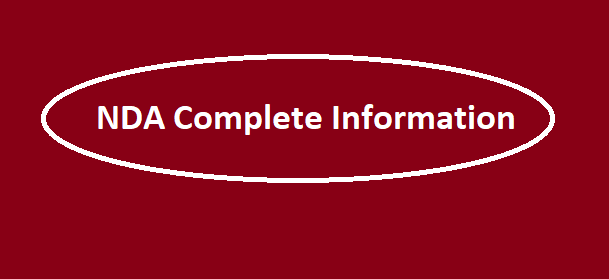UPSC conducts NDA twice a year for motivated individuals who want to establish themselves as officers in Indian Army; Navy & Air Force. NDA is a highly coveted job opportunity for aspirants who want to serve the nation. It comes under one of the prestigious exams category in the country and hence aspirants are required to prepare well for it. This Article will provide readers, the core syllabus for NDA which an aspirants must cover in order to crack the exam. NDA syllabus 2022 will provide you every minute detail that must be prepared. Candidates are recommended to read the complete article to know the foundation of NDA Syllabus 2022.
NDA Syllabus 2022
The NDA Syllabus is composed of Mathematics subject and General Ability. Candidates are suggested to go through the NDA syllabus as mentioned below –
Mathematics Syllabus
|
Trigonometry |
· Properties of triangles, Angles and their measures in degrees and in radians
· Inverse trigonometric functions · Trigonometric identities Sum and difference formulae · Trigonometrical ratios · Applications – Height and distance · Multiple and Sub-multiple angles. |
|
Algebra |
· Geometric and Harmonic progressions
· Solution of linear inequations of two variables by graphs · Complex numbers – basic properties, modulus, Conversion of a number in decimal system to binary system and vice-versa · Cube roots of unity · Arithmetic, argument · Binary system of numbers · Representation of real numbers on a line · Binomial theorem and its application · Quadratic equations with real coefficients · Permutation and Combination · Logarithms and their applications. |
|
Differential Calculus |
· Geometrical as well as physical interpretation of a derivative – applications, increasing and decreasing functions, Continuity of functions – examples, algebraic operations on continuous functions
· Concept of a real valued function – domain, range and graph of a function, Notion of limit, Standard limits – examples · Application of derivatives in problems of maxima and minima · Geometrical and physical interpretation of a derivative – applications · Derivative of a function at a point, Derivatives of sum, product and quotient of functions, derivative of a function with respect of another function, derivative of a composite function and Second order derivatives. |
|
Vector Algebra |
· Vectors in two and three dimensions
· Geometrical problems, magnitude and direction of a vector, Unit and null vectors, addition of vectors, Vector product and cross product of two vectors · Scalar multiplication of vector, scalar product or dot product of two-vectors · Applications-work done by a force and moment of a force |
|
Integral Calculus and Differential equations |
· Integration by substitution and by parts
· Trigonometric, Definition of order and degree of a differential equation · Standard integrals involving algebraic expressions · Solution of first order and first degree differential equations of various types – examples. · Evaluation of definite integrals – determination of areas of plane regions bounded by curves – applications · Formation of a differential equation by examples, exponential and hyperbolic functions · General and particular solution of a differential equation · Integration as inverse of differentiation · Application in problems of growth and decay. |
|
Matrices and Determinants |
· Types of Matrices
· Adjoin and inverse of a square matrix · Operations on matrices · Determinant of a matrix · Applications – Solution of a system of linear equations in two or three unknowns by Cramer’s rule and by Matrix Method, basic properties of determinant. |
|
Statistics |
· Frequency distribution
· Classification of data, cumulative frequency distribution · Graphical representation – Histogram · Measures of Central tendency – mean, median and mode · Pie Chart, Frequency Polygon · Variance and standard deviation – determination and comparison · Correlation and regression. |
|
Probability |
· Outcomes and associated sample space
· Binomial distribution · Random experiment · Examples of random experiments giving rise to Binomial distribution, events, mutually exclusive and exhaustive events · Bayes’ theorem – simple problems, impossible and certain events · Binomial distribution, examples of random experiments giving rise to Binomial distribution · Complementary, elementary and composite events · Union and Intersection of events · Definition of probability – classical and statistical – examples, Conditional probability · Random variable as function on a sample space · Elementary theorems on probability – simple problems |
|
Analytical Geometry of 2D & 3D |
· Distance formula
· Equation of a circle in standard and in general form · Ellipse and hyperbola · Angle between two lines · Rectangular Cartesian Coordinate system · Equation of a line in various forms · Point in a three-dimensional space · Distance between two points · Standard forms of parabola · Equation of a plane and a line in various forms · Distance of a point from a line · Eccentricity and axis of a conic. · Equation of a sphere · Direction Cosines and direction ratios, angle between two lines and angle between two planes. |
General Ability Syllabus
The NDA syllabus of General Ability covers 2 major parts –
Part A
English: This part of syllabus includes – English Grammar and usage, vocabulary, comprehension and cohesion to check the competence of aspirant in English.
Part B
General Knowledge: This part of general knowledge covers topics on subjects like Physics, Chemistry, General Science, Current Events, Social Studies – Polity, Geography, Economics and History.
Physics
| · Motion of objects
· Newton’s Laws of Motion · Force and Momentum · Parallelogram of Forces · Stability and Equilibrium of bodies · Gravitation, elementary ideas of work · Velocity and Acceleration · Power and Energy · Sound waves and their properties · Simple musical instruments · Natural and Artificial Magnets · Properties of a Magnet · Earth as a Magnet · Siphon · Levers · Balloon · Pumps · Hydrometer · Pressure Cooker · Thermos Flask · Gramophone · Telegraphs · Telephone · Periscope · Telescope · Microscope · Mariner’s Compass · Lightening Conductors · Safety Fuses · Simple Pendulum. |
· Simple Pulleys
· Physical Properties and States of Matter · Mass · Weight · Volume · Density and Specific Gravity · Principle of Archimedes · Pressure Barometer · Effects of Heat · change of State and Latent Heat · Modes of transference of Heat · Rectilinear propagation of Light · Reflection and refraction · Spherical mirrors and Lenses · Human Eye · Static and Current Electricity · Measurement of temperature and heat · Conductors and Non-conductors · Ohm’s Law · Simple Electrical Circuits · Heating · Lighting · Magnetic effects of Current · Measurement of Electrical Power · Primary and Secondary Cells · Use of X-Rays. |
Chemistry
| · Oxidation and Reduction
· Material used in the preparation of substances like soap, Glass, Ink, Paper, Cement, Paints, Safety Matches, and Gun-Powder · Carbon – different forms · Preparation and Properties of Hydrogen, Oxygen, Nitrogen and Carbon-Di-oxide · Physical and Chemical changes, Symbols, Formulas and simple Chemical Equations · Law of Chemical Combination (excluding problems) · Properties of Air and Water, Acids, bases and salts, Elements, Mixtures and Compounds · Basic Knowledge of the Structure of Atom, Atomic, Equivalent and Molecular Weights, Valency · Fertilizers – Natural and Artificial |
General Science
| · Constituents of food
· Balanced Diet · Basis of Life – Cells, Protoplasm and Tissues · Achievements of Eminent Scientists · Difference between the living and non-living · Basic knowledge of human Body and its important organs · Food – Source of Energy for man · Growth and Reproduction in Plants and Animals · Common Epidemics, their causes and prevention · The Solar System – Meteors and Comets, Eclipses. |
History
| · Freedom Movement in India, Bhoodan, Sarvodaya, National Integration and Welfare State
· Basic Teachings of Mahatma Gandhi · A broad survey of Indian History with emphasis on Culture and Civilization · Basic knowledge of Five Year Plans of India · Basic study of Indian Constitution and Administration, Panchayati Raj etc · Forces shaping the modern world -Renaissance, Exploration and Discovery · War of American Independence, French Revolution, Industrial Revolution and Russian Revolution · Impact of Science and Technology on Society · Concept of one World · United Nations · Panchsheel · Democracy, Socialism and Communism · Co-operatives and Community Development · Role of India in the present world. |
Geography
| · Origin of Earth
· Weathering – Mechanical and Chemical · Earthquakes and volcanoes · Atmosphere and its composition · Temperature and Atmospheric Pressure · Rocks and their classification · Planetary Winds · Cyclones and Anti-cyclones · Humidity, Condensation and Precipitation · Major Natural regions of the World · Important Sea ports and main sea, land and air routes of India · Main items of Imports and Exports of India · Types of Climate · The Earth, its shape and size, Latitudes and Longitudes · Concept of time · International Date Line · Movements of Earth and their effects · Ocean Currents and Tides · Regional Geography of India – Climate, Natural vegetation, Mineral and Power resources, location and distribution of agricultural and industrial activities. |
Current Events
This part of the exam is quite the trickiest one since anything under the sun could be asked in the question paper under this section. Aspirants must prepare this section by regularly following the newspaper. They should update themselves with the happenings in the country as well as those events happening on world panorama. They may prepare their own notes for such important events; this will enhance their memory and help them during the exam.
Along with the syllabus, you should carefully read the exam pattern. It will help you during the preparation of the exam.





Ish bar kiya only maths and Gk aiga NDA mai
Sir main nda ka written ke saath interview ki tiayari kaise kare
i have chosen arts in 10th and i have to go in NDA so it is compulsory to give Mathematics and physics exam ?
i have chosen arts in 10th and i have to go in NDA so it is compulsory to give Mathematics and physics exam?
No its not necessary